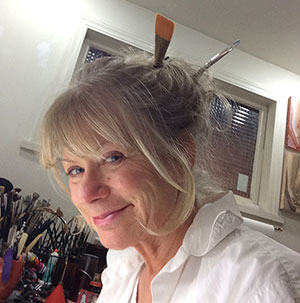
For this interview, we turn to the illustrator of a new book, all ears, all eyes, whose work I’ve long admired. This is a very special book. Open it and you’ll be captivated by the forest at night. Such unusual art! But, then, her prior books have also been distinctive, each in their own way. I hope you enjoy this visit with Katherine as much as I did.
In each of your recent books, Katherine, you’ve used a different illustration style. All the Water in the World is whooshes and swooshes, whirls and swirls, liquid on paper.
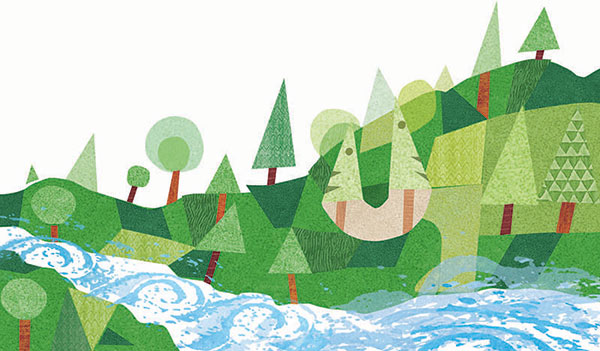
For Shoe Dog, your pages were light-hearted, full of chaotic energy that portrayed Megan McDonald’s dog who finds shoes irresistible.
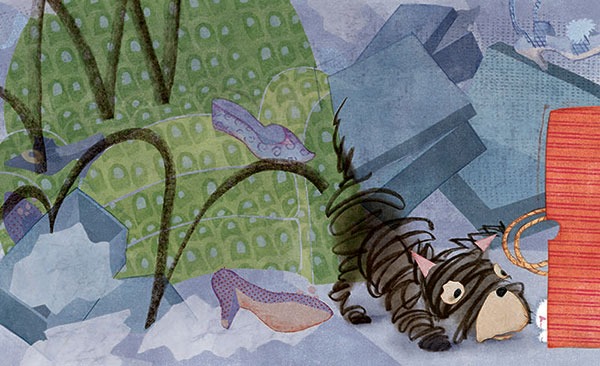
For It’s Picture Day Today!, you assembled familiar home and schoolroom crafting supplies into adorable creatures preparing for picture day. I like to imagine you folding paper and sorting through buttons and peeling glue off your fingers during the making of this book.
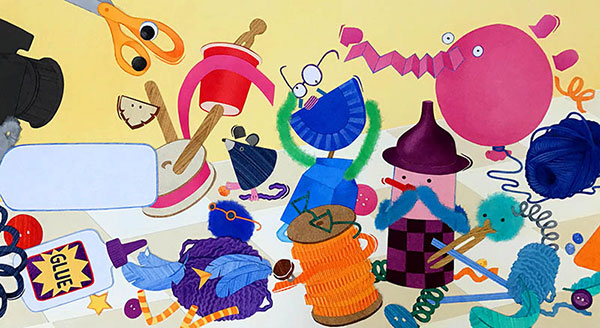
In your newest book, all ears, all eyes, you’ve accomplished yet another completely different look. Your portrayal of the forest in the dark brings the night to life. The reader is deep inside the forest, seeing it, feeling it, while Richard Jackson’s poetry provides the sound track.
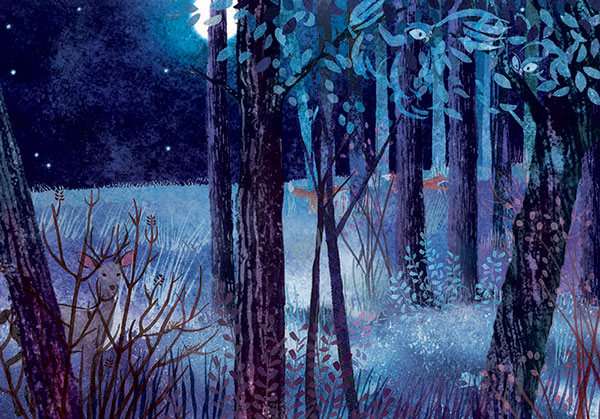
I find myself with lots of questions!
When an editor sends you a manuscript, what happens in your mind as you’re reading it?
I always hope to have my imagination awakened. I usually do not have an idea where I might take a new story with the illustrations but I can perceive an opening for my part of the storytelling. If it is the right manuscript for me, there is a feeling of excited anticipation.
What moves you to agree to a project, knowing it will take you (how long?) to create the illustrations?
I am slow and it is a long time from beginning to end. I can easily slip into being hopelessly overwhelmed or impossibly anxious. It is always best if I think of the process in small steps instead of a distant destination. Collaborators are also invaluable. Many a time, my editor or art director has helped me through a bumpy bit along the way. And I belong to a most wonderful critique group. Together we cheer and help each other move the books forward.
How do you begin a new book?
I love to sit down in a comfy chair with a cup of coffee, the manuscript, and a big pile of books. The books are often on artists but I also have a large collection of Bologna Annuals. I keep a sketchbook nearby and let my mind and my pencil wander.
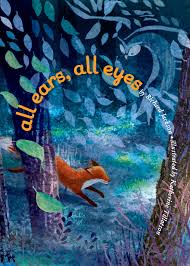 For all ears, all eyes, the title page reveals that you combined watercolor and digital techniques. Could you tell us more about this process?
For all ears, all eyes, the title page reveals that you combined watercolor and digital techniques. Could you tell us more about this process?
I struggled a lot with technique for this book. Early on, I experimented with acrylic and oil. Neither worked. I really wanted to use watercolor and I even had a few lessons from my friend, Julie Downing, a very accomplished watercolor illustrator, I longed to lay down the paint with the confidence of a master, yet I did not have time to master the technique. Watercolor involves a lot of layering (Julie tells me she can have fifty to eighty layers on a painting). Yet I found the more layers I added to a painting, the more I was afraid I would mess up. With each new layer, my rendering became stiffer and stiffer. In mulling over the problem, I thought I might paint more expressively if I knew I could layer in Photoshop, thus discarding any layers I did not like and keeping only those I did. This technique gave me the freedom I craved.
Do you make a conscious effort to make each book quite different? Why?
No, it really isn't a conscious or intellectual choice. There are so many ways to make marks. Shoe Dog was originally going to be rendered in oil. When he developed into a scribble, it just felt right.
Well and then there is the fact that I love art supplies so much. I could spend almost as many hours in an art supply store as in a bookstore.
Do you study other illustrators’ work? What do you see when you do?
Oh, yes! Definitely! There are wonderful illustrators—from all over the world. I have so many favorites. My shelves are overflowing with their picture books. I try to use the library or my book buying habit could easily spin out of control.
Most of all, I love how illustrators extend and enhance the storytelling, stretching beyond the words. An example would be Migrant, illustrated by Isabelle Arsenault. Well, and then there is Chris Raschka. I love the expressive power of his work. Something I am always aspiring to. I could keep going and going… I find so much to admire and inspire in my fellow illustrators’ work.
For all ears, all eyes, you illustrated a Richard Jackson manuscript. He has been your editor for 15 years. Now he’s the author. It is typical in the publishing process that author and illustrator don’t communicate directly, but rather indirectly through their editor. How did that work for this book?
When we began, Dick was very involved in both authoring and editing the book. As the process continued, he began to focus more on his writing life. My communication continued with my new editor, Caitlyn Dlouhy, and my art director, Ann Bobco.
I miss Dick as my editor. He is really the one who taught me how to think about picture books, but I was losing my vision of the book and trying to please everyone. My process was becoming scattered and disconnected. When we returned to a conventional communication model, the book resumed taking shape.
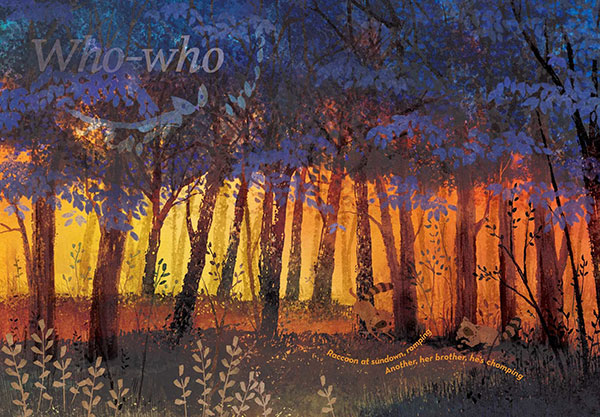
There is nothing about the illustrations in this book that whispers “digital” to me and yet the copyright page says “a combination of watercolor and digital techniques.” Would you share with us how your digital skills have evolved?
Thank you! I use very few of the functions available in Photoshop. Most of my computer time has to do with scanning and placing the layers (and there are lots of layers). I am constantly trying to find ways to minimize my time on the computer and spend most of my time sketching and painting. I believe that the drawing board is where I can find the looseness and emotion I want.
When you went to art school, what was your vision of your artistic future?
I graduated from the University of Colorado with an art major with an education minor. I have always loved making art, but I did not have a clear vision of how to find a career that incorporated art making. I took night classes to develop new art-related skills and through happy coincidence met a fellow student who introduced me to Harcourt in San Francisco. For many years, I designed educational books during the day and worked on illustration samples at night and weekends. It wasn't until I painted this little guy (an early version of what evolved into Shoe Dog) that doors began to open. Dick Jackson saw the piece and took a chance on me.
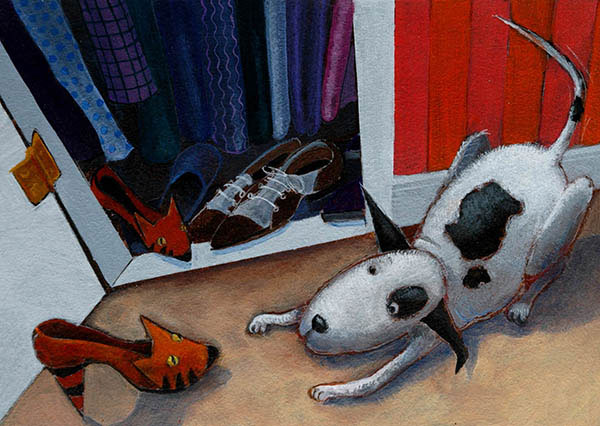
What is your vision of that future now?
I would love to write and illustrate a story. I have a couple ideas that I am thinking about and a few characters rattling around in my head. Now if I could just get them to come out and play....
Don’t miss Bookology’s interview with the author of all ears, all eyes, Richard Jackson.
______________________
Thank you, Katherine, for letting us peek inside your process, your work, and your passion as an illustrator. We always look forward to the next book you’re creating.

You’re new book looks beautiful, Katherine, but that’s no surprise. I look forward to being able to sit down and look through the entire book, page by page.